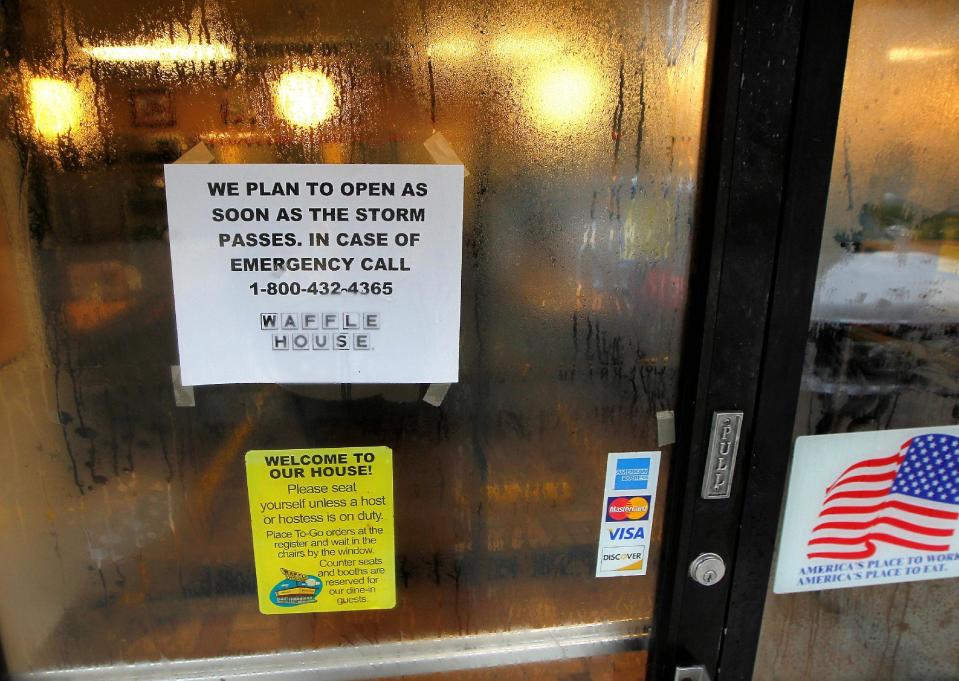Here's what FEMA told us about the Waffle House Index

A day before Hurricane Matthew battered the southeast, Georgia-based fast food chain Waffle House tweeted that “all restaurants on 1-95 between Titusville, FL and Fort Pierce, FL are closed.”
Although the restaurant chain’s Twitter account only has around 66,900 followers and is hardly retweeted, 1,980 people retweeted that post.
Every hurricane season, lore about Waffle House’s relationship with hurricane preparedness and disaster relief emerges, including the “Waffle House Index,” which legend maintains is a proxy used by the Federal Emergency Management Agency (FEMA) for how bad things are. “Green” is full operations, “yellow” is a partial menu with generator power, and “red” is the apocalypse.
According to FEMA, a lot of this is actually true.
“It’s an informal relationship,” Philip Strouse, FEMA’s Private Sector Liaison, told Yahoo Finance. “Waffle House stays on when the wind’s blowing—they never close. They have a small footprint, they’re easy, and if these little stores are going out when it only takes a few people to staff…that’s bad.”
So resistant to closure is this chain – which has about 2,100 locations, mostly in the South – that in the aftermath of Hurricane Katrina in 2005, Strouse said some Waffle House managers actually had a hard time finding the keys to the doors because they close so infrequently.
According to Strouse, the very unofficial index all started when FEMA Administrator Craig Fugate was director of the Florida Emergency Management Division. Noticing Waffle House’s incredible resilience in the face of natural disaster, Fugate coined the index in May 2011 after the Joplin, Mo., tornado. “He was saying if the Waffle House closes, it’s really bad and you know to go to work there first.” So when he came to FEMA in 2009, Fugate brought his barometer to the new position.
Many people misunderstand how the index works, however—a fact that’s partially represented by the response to that Waffle House tweet on Wednesday and articles like this. As an emergency management agency, FEMA handles the aftermath more than the run-up, funneling federal assets to damaged areas that need it most. “We really support the state and the state supports the local community,” said Strouse.
Hurricane Isaac Puts FEMA @WaffleHouse Index to Work http://t.co/jKaF6qDQ
— Billy Corben (@BillyCorben) August 29, 2012
This means you should pay closer attention to the index post-hurricane. “The index was for aftermath, for damage assessments,” said Strouse. The chain’s ability to function on essentially nothing also makes it a prime location for first responders, who know they can get something to eat—almost no matter what.
As a Waffle House spokesperson told Eater on Friday, “Once the storm is over, if we are able to open without power we will operate on a limited menu until power resumes or we are able to operate on generator.”
But that’s not to say it’s not useful to know about store closings before the fact. In addition to Waffle House, FEMA pays attention to much of the private sector goings-on in the days before impact, seeing who evacuates and closes and who stays open.
“It gives us a feel for what is actually happening—like social media—from the private sector side,” said Strouse. FEMA doesn’t endorse or favor any specific companies, but communicates with much of the private sector: big-box stores, Lowe’s, Home Depot, FedEx, UPS, and other restaurant chains like Chick-fil-A and Arby’s. All this provides a signal in aggregate whether communities are really evacuating, giving the agency valuable intel as to what the challenges will be when the winds die down.
Likewise, says Strouse, the agency and other official bodies communicate valuable information to the private sector. “It’s all the info they need and we need—it’s reciprocal. They look at the public sector, and they want to know when the governor is going to declare an emergency or do evacuations and close schools. It gives them planning assumptions to save time and money, and to turn off lights and lock doors based on when evacuations take place.”
As of publication, 48 Waffle House restaurants are closed for Hurricane Matthew.
Ethan Wolff-Mann is a writer at Yahoo Finance focusing on consumerism, tech, and personal finance. Follow him on Twitter @ewolffmann.
Read more:
Survey: Young people don’t like video news
Amazon’s free stuff policy wrecks its reviews
Where is the $60 million Wells Fargo clawed back from its executives going?
Basic math shows why chip cards are sending ripples through retail
Google’s new Pixel phone has a huge advantage over other Android phones
